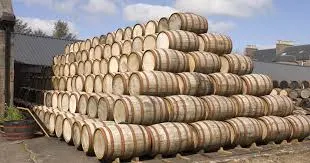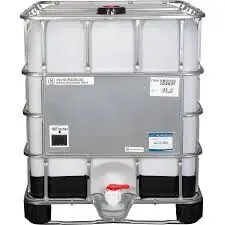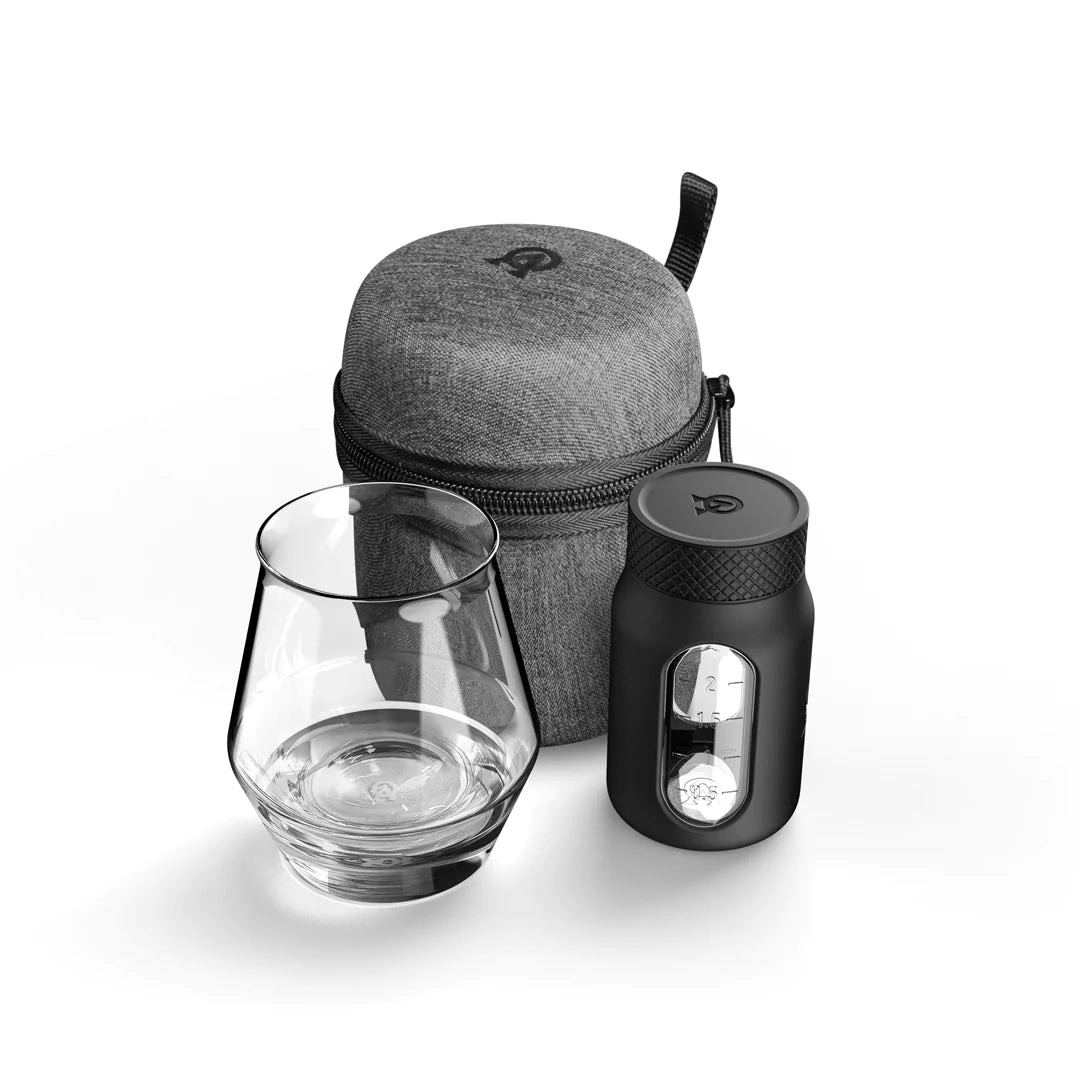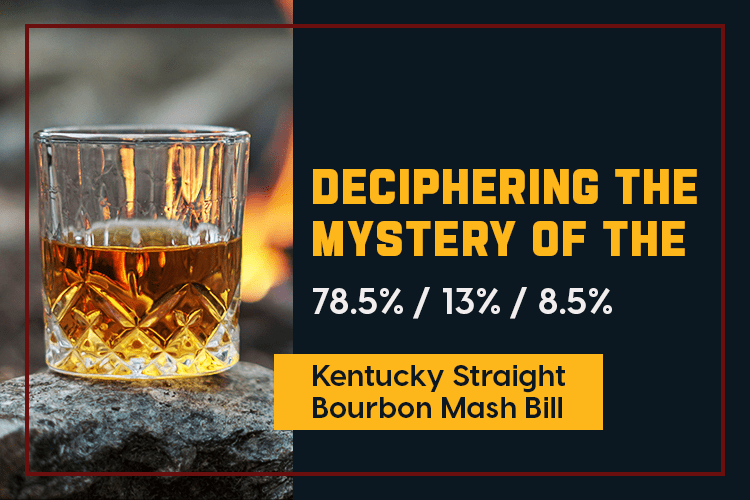| Don't like ads? | No ads |
*Bourbon Culture is reader-supported. When you buy through links on our site, we may earn an affiliate commission.
As each month passes it seems as if the number of new bourbon drinkers in the world doubles. This is not a quantified observation, but the people that have been chasing rare bourbon for a while now are realizing that the amount of like-minded hunters continues to grow.
As a result, bourbon shortages are still very much a thing and finding high proof, highly aged bourbon is even harder. Aged stocks of whiskey, particularly Kentucky Bourbon, have simply vanished.
But an interesting thing has happened in the last year. A strange new mashbill has appeared in the bourbon landscape that seems to have no decipherable distillery that it came from.
The stories and opinions on where it may have come from are as wild as they are unverified. So what is the deal with this 15 year-old Kentucky Bourbon with the strange mashbill of 78.5% corn, 13% rye and 8.5% malted barley?
Slipping in Undetected
The 78.5/13/8.5 mashbill started to surface with a degree of curiosity in early 2020. At that point, the Non-Distiller Producer (NDP) Doc Swinson’s released their “Release #6” that carried the 15 year age statement along with this strange mashbill.
Whenever an NDP would release a batch containing this bourbon, it usually yielded about 1000 bottles (which is a trait of this bourbon that we’ll get to in a minute).
Rumors quickly started to swirl that this was cask strength Wild Turkey because the mashbill seemed similar enough to them.

Later on, a rumor began to float that this mashbill was distilled and aged at Heaven Hill. Rumors even persisted that the barrels had “Wild Turkey” stamped on the top.
But as with all rumors, this one was impossible to verify for one very simple reason: this bourbon was not even being sold in the original oak barrels. Instead, bourbon brokers were selling it by the “tote.”
Totes, explained.
When you think of how bourbon is stored and aged, “totes” are likely not an image that we think of. For those in the food and beverage industry or any industry that must move around large quantities of liquid, totes are extremely common.
They usually come in a variety of sizes but are essentially a giant plastic box or tub that is sealed and has a protective steel cage around it.
They’re easy to move via forklift and can be stacked on top of each other for more space efficiency. Since they are sealed, the contents are generally free from leaks and evaporation (unlike wooden barrels).
The plastic used is likely food-grade and there’s very little risk of petroleum chemicals leaching into the liquid inside.

The term “totes” began to take off once some NDPs started to talk about how their barrel brokers (a kind of middle-man between distilleries and NDPs that source and sell bourbon) were selling the bourbon to them.
The prices and volume were set, but aside from the age statement and mashbill listed on the outside, there were no further clues as to where it was from.
So for a person to say that this was Heaven Hill bourbon marked with Wild Turkey on the top of the barrel is not only strange, but also unverifiable since all of this bourbon was never sold to the customer in barrel form.
Why totes?
In the world of distilling whiskey, “vats” have been used for decades as the primary receptacle to not only blend whiskey in, but to store it for later use.
After all, once a whiskey has reached peak maturation, it needs to be removed from the barrel or else it risks becoming over-oaked or worse.
Distilleries typically use stainless steel vats to store them in, but they are expensive and not easily moved. And if you’re eventually selling that whiskey, it’s unlikely that you will sell the stainless steel vat with it.
So if a distillery knew they were not going to use this distillate for their own products, packaging it for quick sale and transport in a tote is a smart idea. 
Financially, it would also be more efficient to sell and transport these totes than to sell the barrels they came from. A tote occupies roughly the same amount of space as 4 barrels on a pallet.
Four palletized barrels, even if they were topped off with 200 liters each, it would still not be as efficient to move as a tote.
That’s because each tote typically is sold with 1000 liters of liquid in it. In the real world, the volume a tote can hold is equivalent to 8 to 10 fully-aged barrels (so about half the space palletized barrels would take up).
One thing that you’ll also notice about bottlers that are bottling this mashbill is that they are never released as a “single barrel.”
Most batches start around 1000-1300 bottles (or more, depending on if they’re combining totes).
So why was this bourbon even made and why is it coming out now? It is theorized that this bourbon was produced for a customer who ultimately backed out of the deal.
The specific mashbill was made with their specifications so that it would be unique to the bottler. Since the customer no longer existed, the distillery ultimately put it into totes for quick sales to whatever customer it could be unloaded on.
My theory is that it was initially intended to be sold to overseas markets which would explain why this is found bottled up under the “World Whiskey Society” label last year.
But due to the tariff wars from the Trump administration, American whiskey has became almost too expensive to sell at a reasonable price/profit overseas.
But domestic barrel brokers quickly snatched these totes up for quick and easy sales to NDPs hoping to bottle this up under their own labels.
So who made this bourbon?!
First, let’s examine some mash bill facts:
* for reference, the ratios listed below denote Corn % / Rye % / Malted Barley % *
- Heaven Hill Bourbon Mashbill: 78/10/12
- Wild Turkey Bourbon Mashbill: 75/13/12
- Jim Beam Bourbon Mashbill: 75/13/12
- Mystery Mashbill: 78.5/13/8
The most obvious suspects were picked because the mystery mashbill has a common sensory theme that almost all reviewers have picked up on, which is a nuttiness on the nose and palate.
That nuttiness is indicative of the yeast of all three distillers that I mentioned. It should also be noted that it is almost a verified fact that Heaven Hill uses Jim Beam’s yeast.
For those of you who may not know this, Jim Beam was the primary distillery that helped get Heaven Hill back up and running after a fire burned down their entire distillery and destroyed all of their yeast with it.
This is why you may hear of bourbon enthusiasts searching for “pre-fire Heaven Hill bottles” because they want to experience what Heaven Hill used to be before they began using the yeast from Jim Beam.
Some differences obviously still exist between both distilleries, but they are pretty similar overall.
No other traits seem to stand out among reviewers. What I mean by that is if we saw a common trend of “banana notes,” we could assume that it was a Brown Forman product.
If reviewers would comment on fruit notes being dominant, we could possibly assume it was a Sazerac-owned distillery or Four Roses product. And trust me, it’s weird to count out Barton Distillery as a primary suspect!
But after looking at all of these factors, it should be concluded that Beam, Turkey and Heaven Hill are the only distillers that have products that fit into the tasting notes shared by so many reviewers.
Finally, it should be noted that at the time of this article, the NDP Backbone Bourbon released a 15 year Kentucky Bourbon that uses this mashbill and has labeled it “distilled in Frankfort, KY” on the back of the label.
This is a slight misrepresentation of the facts as this tote was likely purchased or picked up from the Jim Beam Old Grand-Dad Plant located at 3200 Georgetown Rd in Frankfort, KY.
This plant has a bottling line, warehouse facility, huge number of storage vats and a large shipping dock on site. Many enthusiasts quickly saw the wording “Frankfort, KY” and automatically assumed that Backbone Bourbon Company was sourcing from Buffalo Trace, but that is simply not the case.
Just tell us who made this stuff already!
After avoiding the answer to this question for the length of this article, it has come down to this. This mashbill that has been wearing a disguise for over a year now has infatuated many.
It’s becoming a household name around bourbon circles as “that weird Kentucky bourbon” that nobody knows where it came from.
It is aged up to 15 years and many bottlers will label it “barrel proof” or “non-chill filtered.” The bottom line is, we don’t know if either of those terms are totally honest because we don’t know what the distiller did to the liquid after dumping the barrels and before it was put into the totes.
A bottler telling us that it was barrel proof or non-chill filtered only means that they did not do add water or chill filter it themselves.
Additionally, there is no federal law that states that a bottle must be accurate in telling where the liquid was distilled from. The only things a bottle must factually state is the proof, the age (when applicable) and the Surgeon General’s warning.
So now I must ask you, the consumer, a question. Just how much is an age statement and the allure of the words “Straight Kentucky Bourbon” on the bottle worth to you?
Does 15 years old automatically mean that the liquid inside is now worth $100? How about $200? More? Because NDPs are currently charging anywhere from $120 to $200 retail for these bottles.
They get to wear the fancy age statement and dance around the ambiguity of where they came from. But the bottom line is that the perceived value of what’s in this bottle is wholly, absolutely dependent on the fact that WE DON’T KNOW where it came from.
If this secret was revealed, it would surely push down the prices back to the point of sanity.
The reason why any bottle that proclaims to have the mashbill of 78.5/13/8.5 is always so expensive is that barrel brokers and bottlers alike are feasting on our own human psychology.
We perceive that this is fantastic bourbon because the mystery and price subconsciously tells us it is.
So the next time you’re looking to drop $200 on that bottle of Whiskey Drummer, Old Soul, Doc Swinson’s (certain batches) and others, just stop.
The reviews are generally hyped up and the liquid has no truly unique traits like a dusty bourbon should.
There are actually bourbons you can get right now all over the United States at a fraction of the price that are just as good. In fact, I’ll just go ahead and tell you what to get: Knob Creek Single Barrels.
At $50, you’re going to get a single barrel of Straight Kentucky Bourbon bottled at 120 proof, aged for 9 to 15 years and non-chill filtered.
I would confidently put this up against any single barrels of Knob Creek because I know they’re extremely similar (Master Pick even claims that their 15 year old release IS JIM BEAM DISTILLATE).
And even if the Knob Creek would lose, I doubt it would be by much. It would still demonstrate that a bottle that is almost ¼ the price of a Doc Swinson’s or Whiskey Drummer can hang with them all day long.
So whenever you hear someone asking where this bourbon came from, give them this question to ponder over: “Is that unidentified Kentucky bourbon that no distillery claims is theirs and that has been setting in plastic tubs for who-knows-how-long really worth your $200?”
Known Bourbons that use the 78.5/13/8.5 mashbill:
Old Bones 15 Year Kentucky Bourbon (Frankfort, KY on the label) -$120+
Master Picke Bourbon Release #3 (they claim this is sourced from Jim Beam) – $unknown
Hardin’s Creek Bourbon Aged 184 Months (this cites Beam as the distiller on the front label) – $unknown
Three Chord Whiskey Drummer 15 Year Kentucky Bourbon -$200
Old Soul 15 Year Old Bourbon – $200
The Prideful Goat 15 Year Kentucky Bourbon – $100
Lone Whisker “The DogFather” 15 Year Straight Bourbon – $600 to $900
Doc Swinson’s 15 Year Old Kentucky Bourbon (Release 6) – $200
Mythology Bourbon (only part of the blend) – $unknown
Chicken Cock Master Distiller’s Pick -$300
Bardstown Bourbon Company Discovery Series #4 (only part of the blend) – $150
Hunt and Gather 15 Year Kentucky Bourbon (they have rounded up the mashbill to indicate it is 79/13/8) – $200
World Whiskey Society Reserve Collection 15 Year Kentucky Bourbon – $700+
Suspected Bourbons that may use the 78.5/13/8.5 mashbill:
St. Cloud Bourbon (12 or 13 year) – $275
Rare Perfection 12 Year Kentucky Bourbon (2020-2021 Release) -$300
Featured Products
- Neat Traveler

- View Larger
- Description:The Aged & Ore Neat Traveler is a complete travel kit for spirits. We combined our widely praised Neat Glass with one of our 3oz Flight Bottles and housed them together in a custom EVA travel case. Perfect for a night away with your favorite pour. The tie
- Bottle Flight

- View Larger
- Description:The Aged & Ore Bottle Flight is a premium set of 4 custom silicone wrapped glass bottles designed to transport and share samples of your favorite spirits. The flight bottles come in a custom EVA travel case that fits perfectly in any small bag. An Aged &
- Travel Bundle

- View Larger
- Description:This Bundle combines two of our crowd favorite products, creating the ultimate travel bundle to bring along your favorite spirits and glassware. Bundle Includes: Neat Traveler (Gray) Bottle Flight (Gray) Note: This bundle is only available in gray and col
*Bourbon Culture is reader-supported. When you buy through links on our site, we may earn an affiliate commission.

